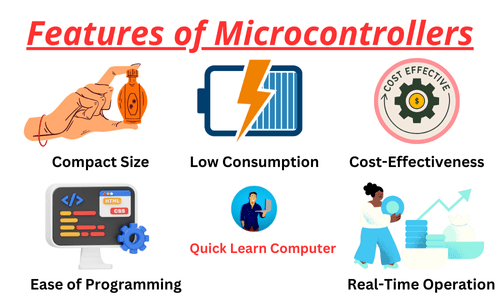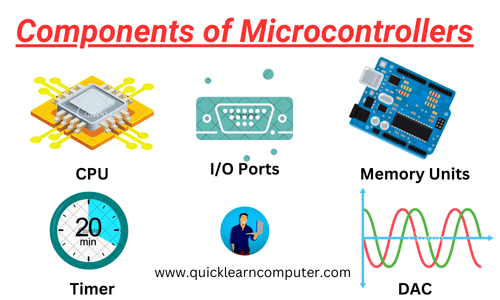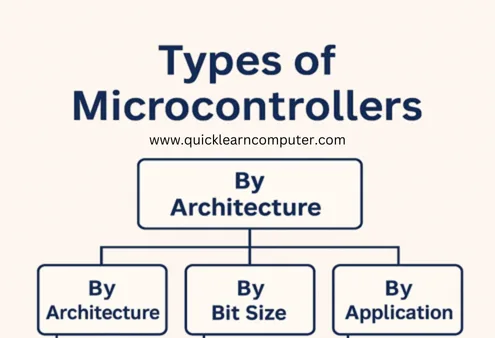Microcontrollers are the tiny brains behind countless electronic devices, from microwave ovens to automobiles. Understanding the features of microcontrollers is crucial for anyone working in electronics, embedded systems, or automation.
In this article, we will explore the key features, supported by examples, types, components, and applications of microcontrollers, to help you gain a comprehensive understanding of this essential technology.
What is a Microcontroller?
A microcontroller is an integrated circuit (IC) designed to perform specific tasks. Unlike general-purpose computers, microcontrollers are optimized for control-oriented applications.
They integrate essential hardware components like CPU, memory, and I/O ports on a single chip, making them highly efficient and compact for embedded applications.
Features of Microcontrollers
Microcontrollers come loaded with features that make them ideal for embedded and real-time systems. Below, we discuss the most important features of microcontrollers.

1. Compact Size and Integration
One of the most striking features of microcontrollers is their small size. They integrate multiple components onto a single chip, including:
- Central Processing Unit (CPU).
- Memory (RAM, ROM, EEPROM).
- Input/Output (I/O) Ports.
- Timers and Counters.
- Analog-to-Digital Converters (ADC).
This high level of integration reduces the need for additional external components, resulting in compact and cost-effective designs.
2. Low Power Consumption
Power efficiency is critical, especially in battery-operated devices. Microcontrollers are designed to consume minimal power, featuring multiple power-saving modes such as:
- Sleep Mode.
- Idle Mode.
- Power-Down Mode.
These modes help extend battery life and are essential for portable gadgets and remote applications.
3. Cost-Effectiveness
Microcontrollers are generally affordable due to their minimal component requirements. Their cost-effectiveness makes them ideal for mass production in industries like consumer electronics, automotive, and healthcare.
4. Ease of Programming
Modern microcontrollers are designed to be easily programmable using high-level languages like C and C++. They often come with development tools such as:
- Integrated Development Environments (IDEs).
- Simulators.
- Debuggers.
- Programmers.
This feature speeds up the development process and reduces time to market.
5. Real-Time Operation
Many applications, such as automotive systems and industrial controls, require real-time responses. Microcontrollers are equipped with features like:
- Interrupt Handling.
- Timers.
- Real-Time Operating Systems (RTOS) support.
These enable them to respond swiftly and predictably to external events.
Components of Microcontroller
Understanding the components of microcontroller is key to appreciating its features:

1. CPU (Central Processing Unit)
The brain of the microcontroller that executes instructions and controls operations.
2. Memory Units
- RAM - Temporary data storage during computer operation.
- ROM/EPROM/EEPROM - Permanent storage for firmware and programs.
3. Input/Output Ports
Interfaces for connecting external devices like sensors, motors, and displays.
4. Timers and Counters
Used for time-related operations like measuring intervals, generating delays, or counting external events.
5. Communication Ports
Support for communication protocols such as:
- UART
- SPI
- I2C
Enabling microcontrollers to interact with other devices and networks.
6. Analog-to-Digital and Digital-to-Analog Converters
Essential for applications requiring interfacing with analog signals, such as temperature sensors.
Types of Microcontrollers
There are various types of microcontrollers, which are given below.

Based on Architecture
- Harvard Architecture - Separate memory for instructions and data (e.g., PIC microcontrollers).
- Von Neumann Architecture - Same memory for instructions and data (e.g., older 8051 microcontrollers).
Based on Bit Size
- 8-bit Microcontrollers - Ideal for simple tasks (e.g., ATMega328).
- 16-bit Microcontrollers - Offer a balance of performance and complexity (e.g. - MSP430).
- 32-bit Microcontrollers: Suitable for high-performance applications (e.g., ARM Cortex-M series).
Popular Examples of Microcontroller
- AVR Microcontrollers - Known for their efficiency and ease of use.
- PIC Microcontrollers - Widely used in industrial and consumer applications.
- ARM-based Microcontrollers - Offer powerful performance and scalability.
Applications of Microcontroller
There are various applications of microcontroller, which are given below.
Consumer Electronics
- Washing machines.
- Microwave ovens.
- Smart TVs.
Automotive
- Engine control systems.
- Airbag systems.
- Automatic braking systems.
Industrial Automation
- Robotic arms.
- Process control systems.
- Assembly line monitoring.
Healthcare
- Portable medical devices.
- Heart rate monitors.
- Infusion pumps.
Other Applications
- Drones.
- Smart home devices.
- IoT sensors.
FAQS
1. What are the main features of a microcontroller?
Microcontrollers are compact integrated circuits designed for specific computer applications. Their main features include:
- CPU - Executes instructions and controls operations.
- Memory Units - Includes RAM for temporary memory and ROM/Flash for program storage.
- Input/Output Ports - Interfaces for connecting external devices like sensors and actuators.
- Timers and Counters - Manage time-related functions and event counting.
- ADC - Convert analog signals to digital data.
- Communication Interfaces - Support protocols like UART, SPI, and I2C for device communication.
- Power Management Features - Include low-power modes to conserve energy.
2. What is the role of timers and counters in microcontrollers?
Timers and counters are used for measuring time intervals, generating delays, counting events, and producing precise output waveforms, essential for tasks like pulse width modulation and time-sensitive operations.
Conclusion
Understanding the features of microcontroller is fundamental for designing efficient and reliable electronic systems.
Their compact size, low power consumption, cost-effectiveness, real-time operation, and easy programmability make microcontrollers indispensable in today's technology-driven world.
Whether you are exploring different types, analyzing components, or studying applications of microcontrollers, it is clear that these small but powerful devices form the backbone of modern embedded systems.